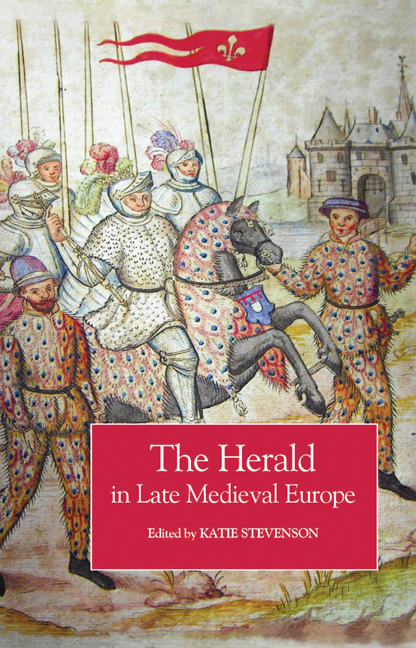Book contents
- Frontmatter
- Contents
- List of Illustrations
- Notes on Contributors
- Acknowledgements
- Abbreviations
- 1 Introduction
- 2 The Development of the Office of Arms in England, c. 1413–1485
- 3 Ancient Precedent or Tudor Fiction? Garter King of Arms and the Pronouncements of Thomas, Duke of Clarence
- 4 Jurisdiction, Authority and Professionalisation: The Officers of Arms of Late Medieval Scotland
- 5 The March of Brittany and its Heralds in the Later Middle Ages
- 6 City Heralds in the Burgundian Low Countries
- 7 King of Arms of the Ruwieren: A Special Function in the German Empire
- 8 Heraldry, Heralds and Politics in the Republic of Florence in the Late Middle Ages
- 9 Tournaments, Heraldry and Heralds in the Kingdom of Poland in the Late Middle Ages
- 10 A time when ‘fools and dwarfs were highly esteemed’? Seeking the Late Medieval Scandinavian Herald
- Index
2 - The Development of the Office of Arms in England, c. 1413–1485
Published online by Cambridge University Press: 26 October 2017
- Frontmatter
- Contents
- List of Illustrations
- Notes on Contributors
- Acknowledgements
- Abbreviations
- 1 Introduction
- 2 The Development of the Office of Arms in England, c. 1413–1485
- 3 Ancient Precedent or Tudor Fiction? Garter King of Arms and the Pronouncements of Thomas, Duke of Clarence
- 4 Jurisdiction, Authority and Professionalisation: The Officers of Arms of Late Medieval Scotland
- 5 The March of Brittany and its Heralds in the Later Middle Ages
- 6 City Heralds in the Burgundian Low Countries
- 7 King of Arms of the Ruwieren: A Special Function in the German Empire
- 8 Heraldry, Heralds and Politics in the Republic of Florence in the Late Middle Ages
- 9 Tournaments, Heraldry and Heralds in the Kingdom of Poland in the Late Middle Ages
- 10 A time when ‘fools and dwarfs were highly esteemed’? Seeking the Late Medieval Scandinavian Herald
- Index
Summary
WITH THE DISSEMINATION AND SYSTEMATISATION of heraldic coat armour throughout the European nobility in the late twelfth and early thirteenth centuries, the opportunity arose for those claiming expertise in armorial matters to offer their services in noble and royal households. Heralds first appear in English records in the reign of Edward I (1272–1307). Those named in the king's household accounts are evidently principal servants using personal names together with the title of ‘king of heralds’, suggesting that a hierarchy of armorial agents was already in place, closely associated with minstrels. In addition to offering expert service in heraldic matters, they acted as marshals of ceremonies for their masters. ‘Private’ heralds retained in a noble household might enter the service of the crown after their master's death. By the reign of Edward III (1327–77), royal heralds were taking on broader military and diplomatic duties, as messengers of war and peace and as supervisors of chivalric tournaments. If chivalry was ‘the secular code of honour of a martially oriented aristocracy’, heralds in the fourteenth century became the king's chivalric administrators. Collectively, the heraldic agents of the royal household comprised the ‘office of arms’, and became clearly subdivided during the fourteenth century into three levels of seniority: pursuivants, heralds and kings of arms. The officers of arms came to be supervised by the Lord High Constable and the Earl Marshal of England who, from at least 1348, also held a joint court of chivalry to administer the law of arms as used in England. Here the heralds could act before the court (much like lawyers) as experts on armorial matters.
The role of armorial officials was constantly evolving throughout the later Middle Ages, and in this regard the turn of the fifteenth century was a time of particular acceleration. Between 1415 and 1417, Henry V (1413–22) created a new officer of chivalry, Garter – ‘Principal’ King of Arms – whose role in part was to oversee the operation of the armorial office. Almost seven decades later, in letters patent dated 2 March 1484, Richard III (1483–5) formally incorporated the office and all its members.
- Type
- Chapter
- Information
- The Herald in Late Medieval Europe , pp. 9 - 28Publisher: Boydell & BrewerPrint publication year: 2009

